Only one person has achieved the honour of featuring in the TFA 2020 and 2021 magazines. That player is none other than Eduardo Camavinga.
Though his big transfer did not materialise last summer, rumour has it that he has officially asked the club to move him in the summer of 2021.
The list of suitors is considerable. Among the global giants, Real Madrid have supposedly expressed an interest in him, as have Manchester United and Bayern Munich.
With a full season of first-team football under his belt and now Champions League experience, the young Frenchman has shown why he’s one of football’s brightest young prospects.
This tactical analysis will build upon the TFA 2020 analysis. When Marko Jović wrote his Camavinga scout report last year, the then 17-year-old was playing a deeper role for Rennes, which will be shown later in this article.
Now that Camavinga is playing in a more advanced position, we’ll look at how his talents have translated higher up the pitch. Further, since the defensive side of his game received so many plaudits last season, this analysis will identify some of the reasons for his lost efficiency this season.
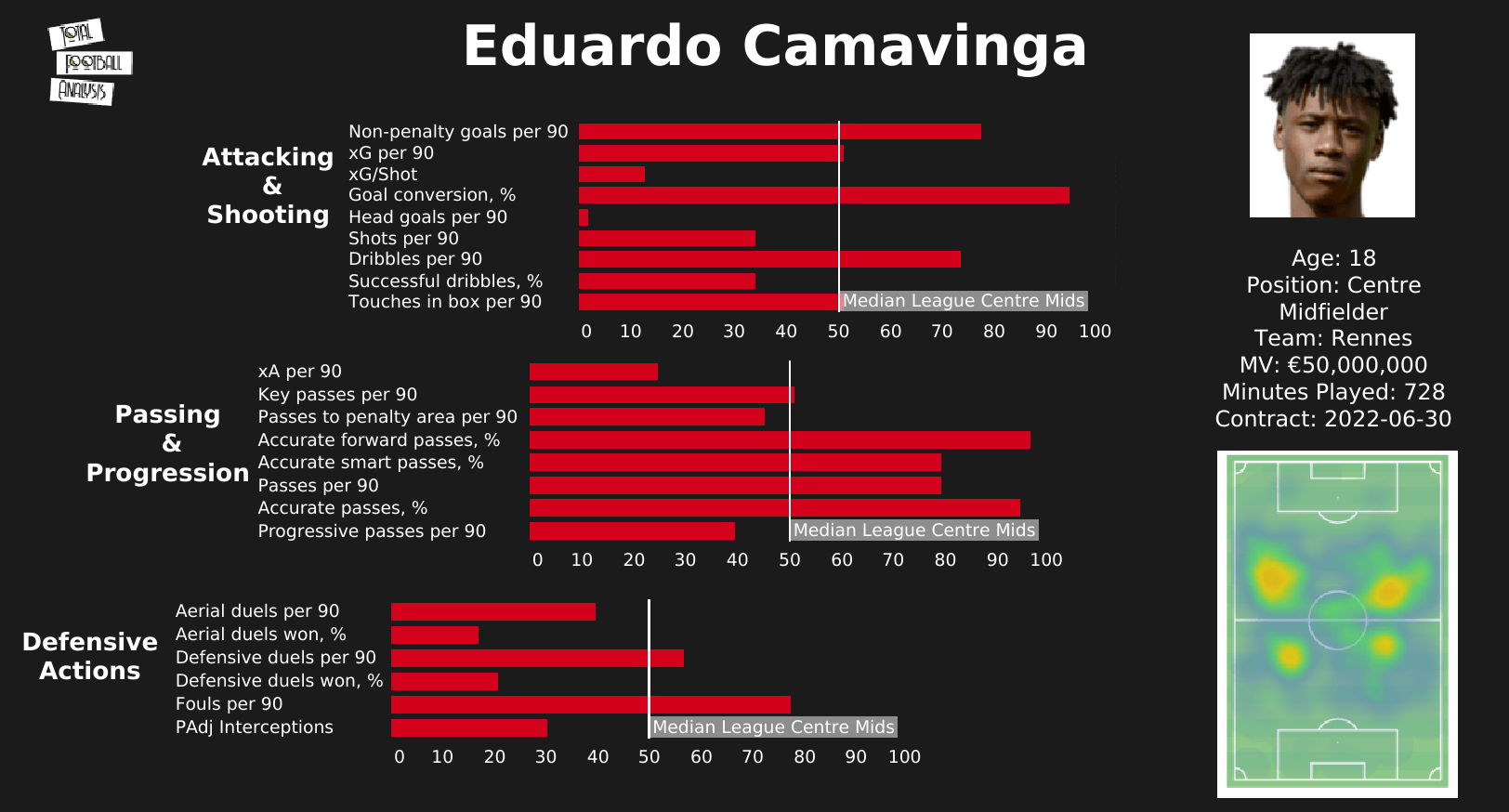
Looking at Camavinga’s 2020/21 season from a statistical and visualisation standpoint, his heat map indicates that he is located primarily in the half-spaces. The four hottest points on the heat map are in the half-spaces on either side of the midfield line.
As you’ll see in this analysis, those four points relate to his roles in the build-up and Rennes’ open attacks in the attacking half of the pitch.
Statistically, Camavinga has outperformed his Ligue 1 centre-midfield colleagues in many of the passing statistics. In particular, his pass completion percentage and passes per 90 minutes (52.91) rate are near the 80th percentile or higher.
Spatial management and time creation
If you’ve studied Camavinga closely, you have surely revelled in his high attacking IQ. He’s a fantastic player to watch, one who exudes intelligence and class both on and off the ball. For a player who only turned 18 in November of 2020, his management of space and ability to buy additional time for himself and teammates are well ahead of his years
As you watch Camavinga operate, notice how often he scans the pitch, adapts his positioning and corrects his body orientation. The French international is always thinking, always trying to buy himself or his teammates additional time through his spatial occupation.
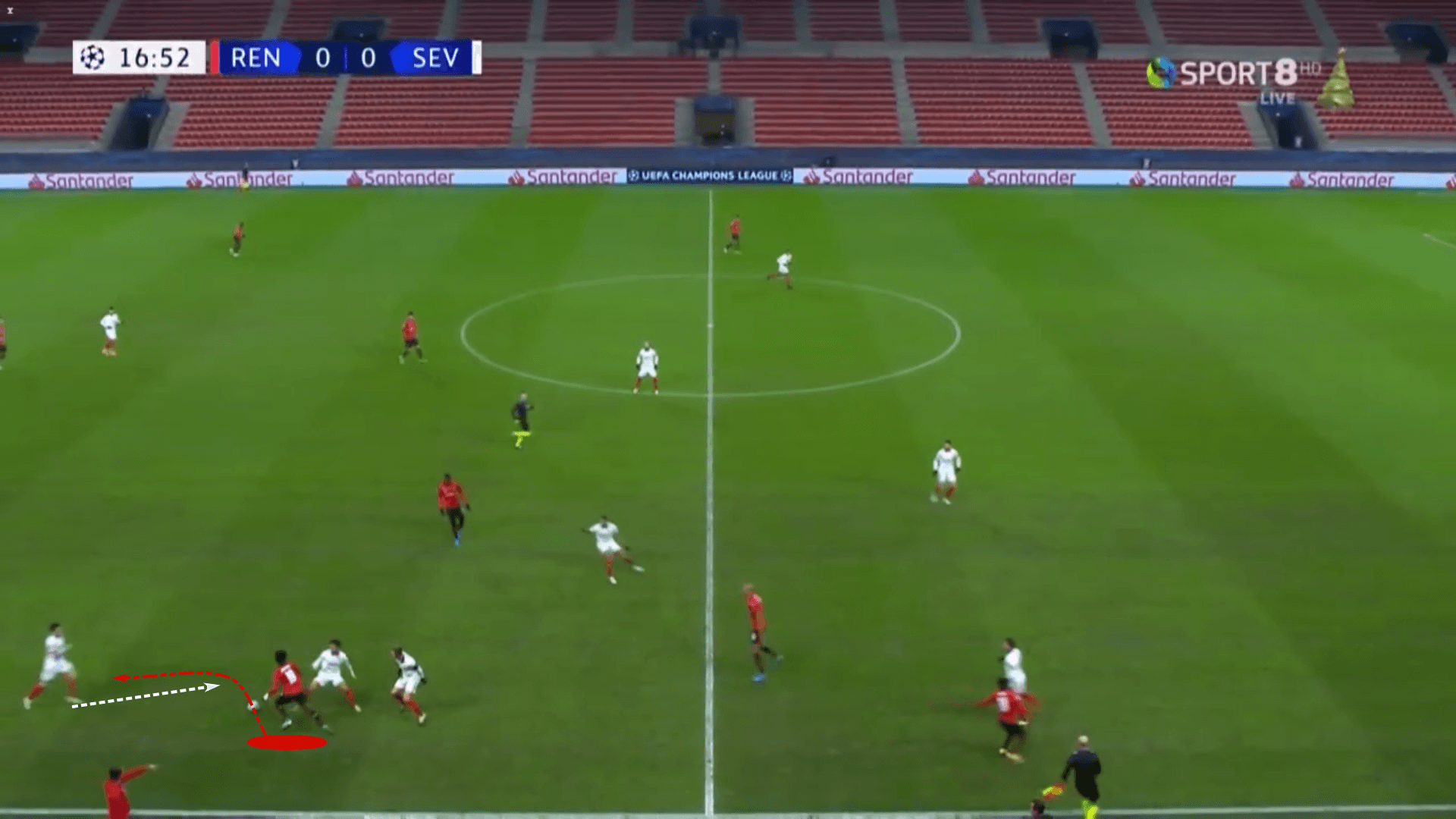
One of his strongest psychological traits is his composure. Rarely troubled or given a problem he can’t solve, Camavinga’s cool demeanor and presence of mine allow him to quickly assess the problem at hand and, typically, make the correct decision. Even in situations where the odds are stacked against him, as in the 1v3, he’s able to quickly assess his options and take decisive action. In this case, he moved away from the pack of two defenders, towards the singular defender, using a cheeky nutmeg to break their pressure altogether and safely play out.
As noted in TFA 2020, Camavinga can play virtually any role in midfield. This season, he’s moved a bit higher up the pitch, allowing Steven Nzonzi to play his customary #6 role. The change in positioning seems to suit Camavinga well and while he still drops in to help with the build-out, Rennes have benefited from his spatial awareness higher up the pitch.
With Nzonzi typically playing a deeper role, Camavinga is free to move higher up the pitch to offer line breaking passing options. Rather than fixating on the ball or floating in the same current as the others, Camavinga cleverley works against the opposition’s momentum and movement to optimise positioning.
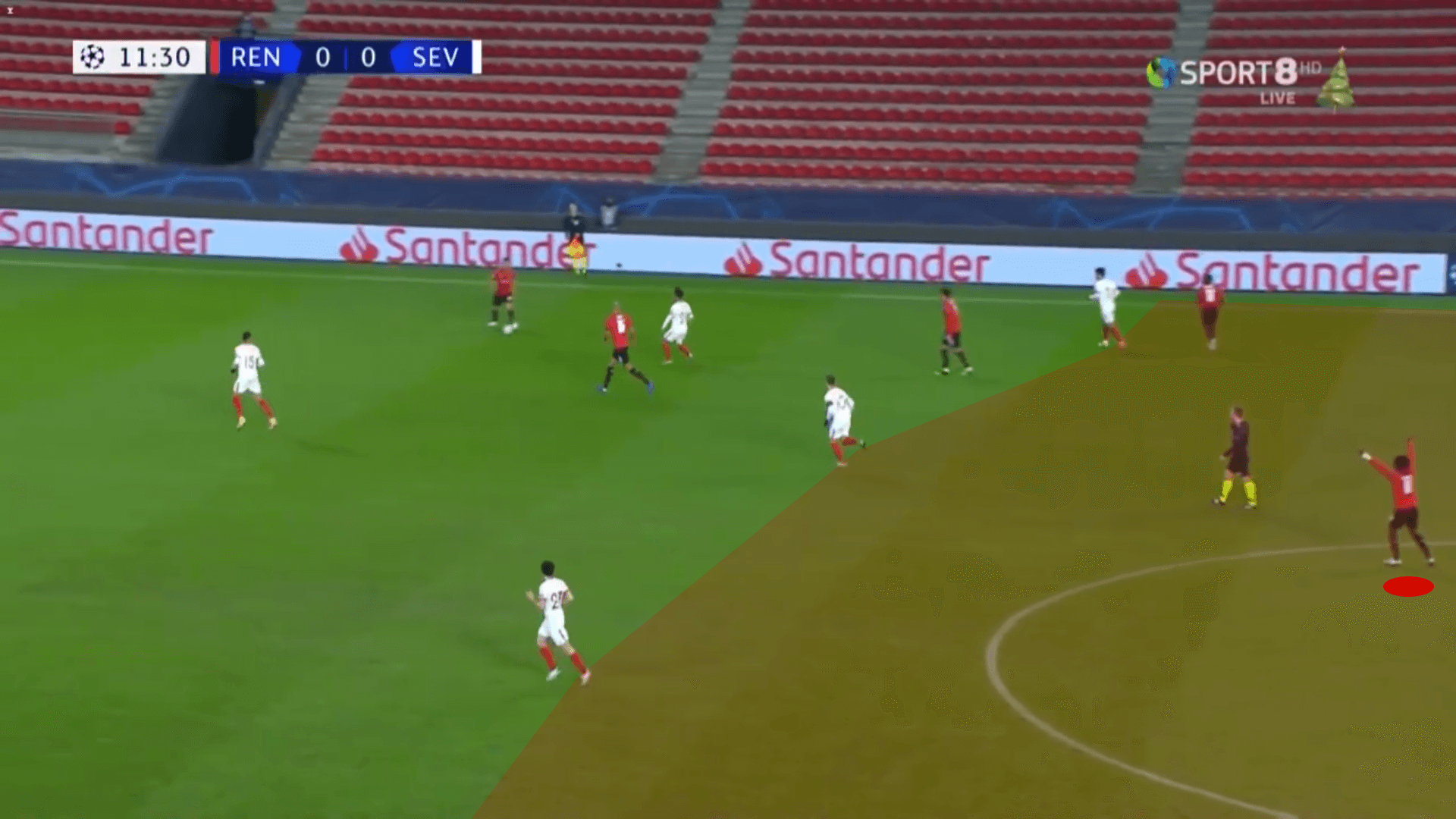
Early in the first half in Rennes’ UEFA Champions League match against Sevilla, Les Rennais were looking to break the La Liga side’s high press. Nzonzi dropped deep to help with the build-out, drawing Sevilla’s midfield higher up the pitch. As the press moved higher, Camavinga maintained his positioning between the opponent’s midfield and defensive lines.
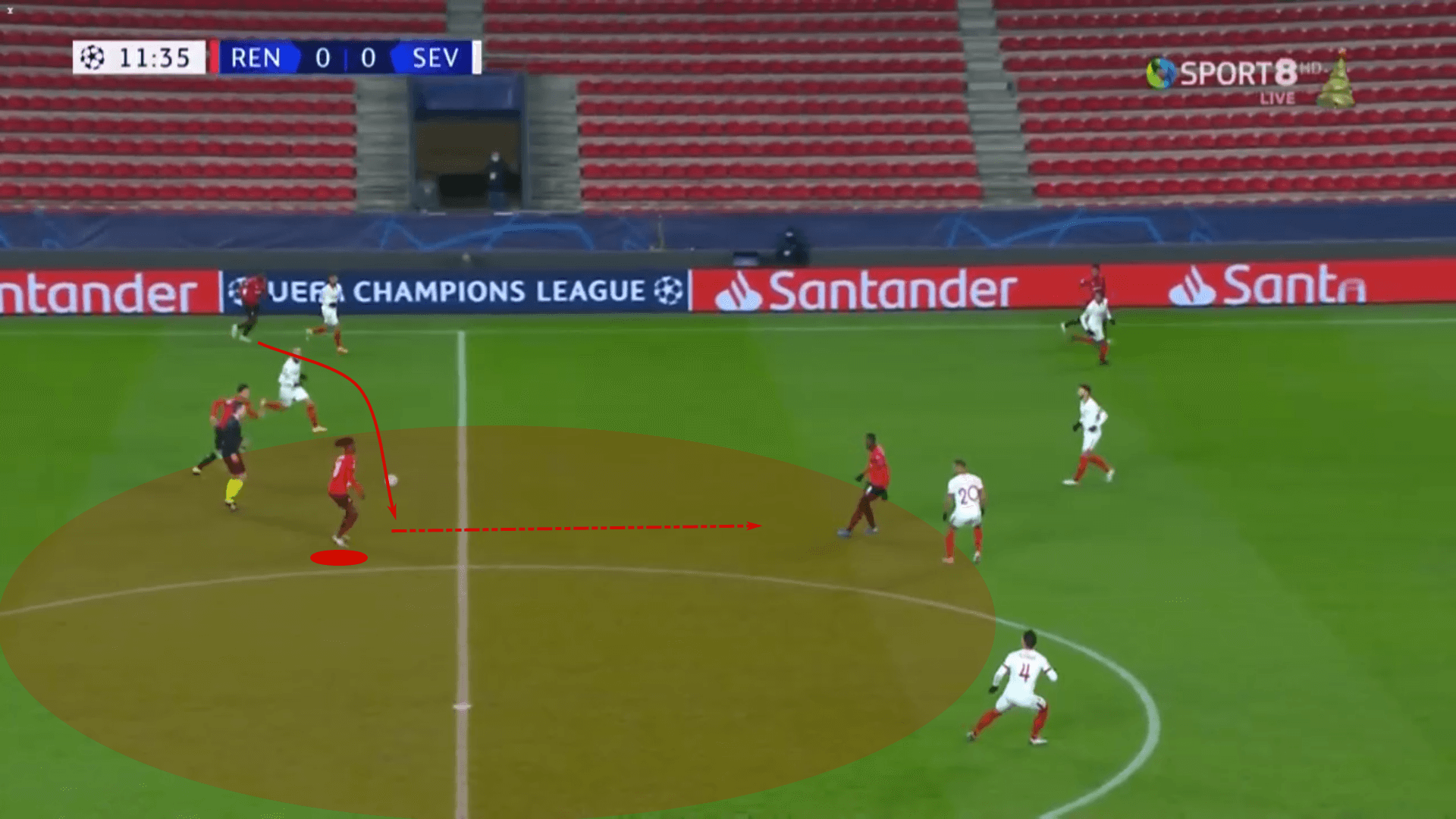
As Rennes broke the initial wave of pressure, Camavinga was perfectly situated to receive the ball and progress via the dribble.
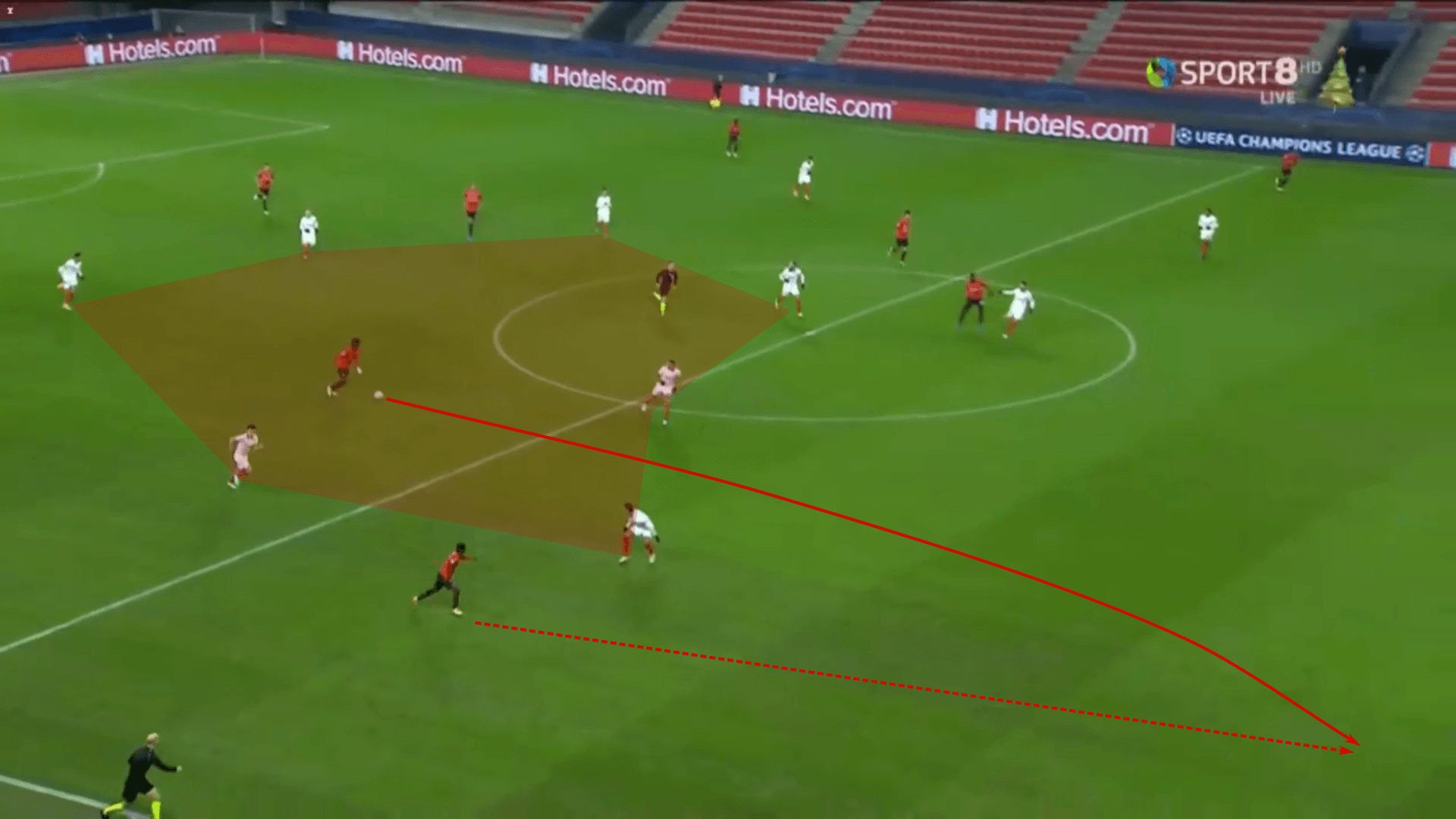
In another example from that Sevilla match, Camavinga again situated himself between the lines. As he received the pass, he took a positive first touch towards the Sevilla back four. As he pulled Diego Carlos out of the backline, a gap emerged for the through ball to Jérémy Doku.
Later when the team moves higher up the pitch, you’ll see Camavinga target half-space starting points, just as you saw on his heat map. Rennes have used both three and four-man midfields this season. Regardless of Julien Stéphan’s choice in tactics, Camavinga does look to move into the half-spaces whenever gaps emerge.
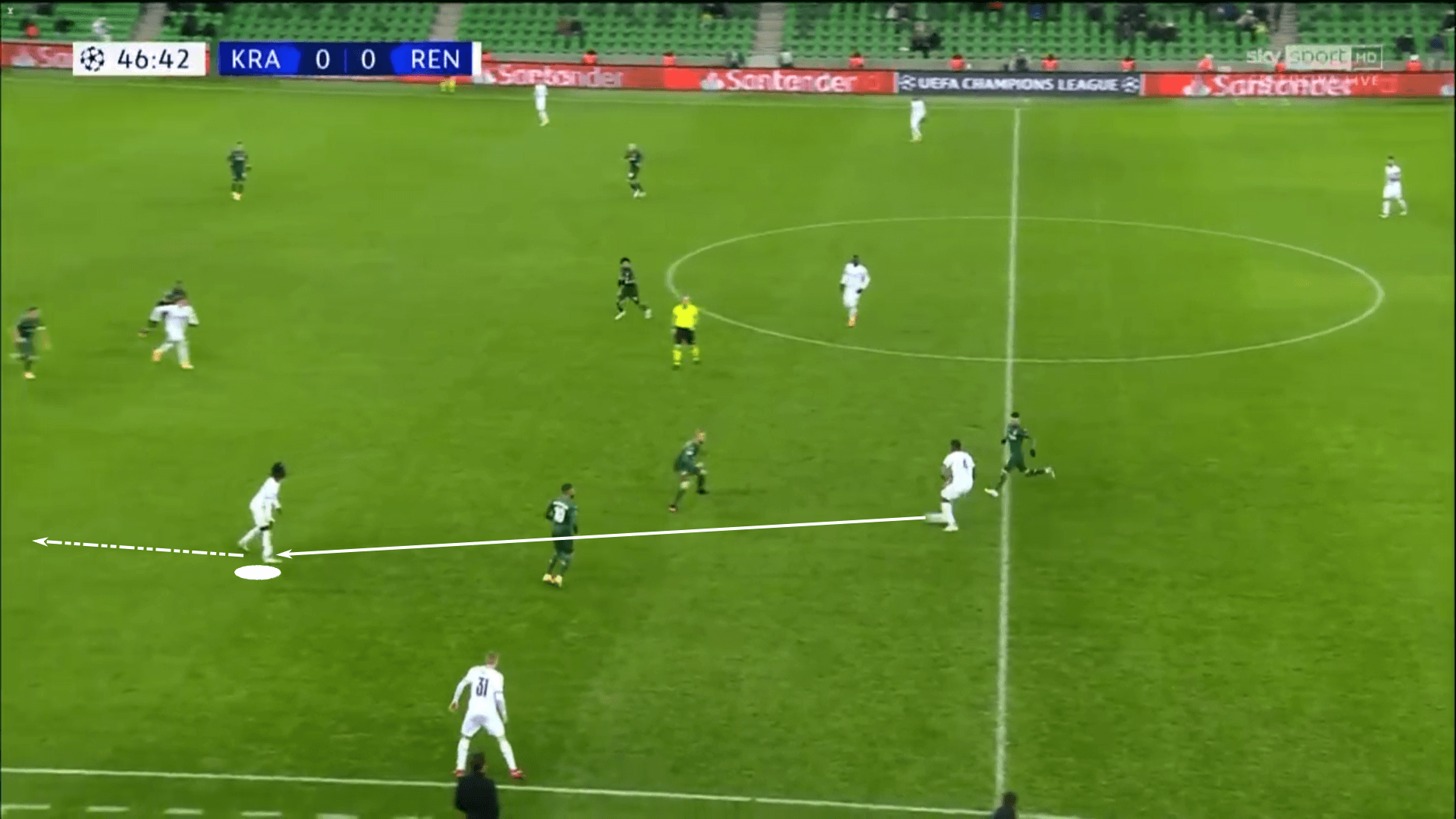
During the Champions League play against Krasnodar, the Russian side engaged the Rennes attack from a middle block with a midfield line of confrontation. Rather than closing the gap and offering a shorter distance pass, Camavinga showed his discipline and intelligence by sitting between the lines to offer the split pass.
As dynamic a player as Camavinga is, his football IQ and management of space and time greatly increase the odds of successful actions, both for himself and his teammates. This aspect of his game is well ahead of schedule and already better than most of his Ligue 1 colleagues. Regardless of his club’s system of play or how the coach tailors his tactics to the opponent, Camavinga has shown the versatility and intelligence to adapt to his role, quickly assessing problems and reaching high percentage solutions.
Roles in progression
Though Camavinga can play a variety of roles in midfield, those tactical responsibilities only influence how he engages throughout Rennes’ attacking phases, not if he’s involved. From one end of the pitch to the other, the youngster is an integral part of his team’s attacking tactics. As Jović mentioned in his TFA 2020 article, Camavinga is the side’s metronome.
With Nzonzi playing a more customary #6 role, Camavinga usually takes a higher starting point to offer a passing option to his deeper teammates. What makes this more interesting is that he often looks to dictate the tempo of the match within lines of the opponent’s press. So often we’ll see a centre-back or #6 quarterbacking play from a deeper starting point that sits outside of the opponent’s press. Sergio Ramos and Toni Kroos of Real Madrid are two examples that come to mind. Deeper or wider starting points buy them a little more time and space to scan the field and play over, through or around the opponent’s press.
Camavinga is different.
Rather than moving outside of the opponent’s press, his ability to find pockets of space between the lines allows Rennes to attack the opponent from a different angle. This tactical versatility is especially seen in the team’s build-up.
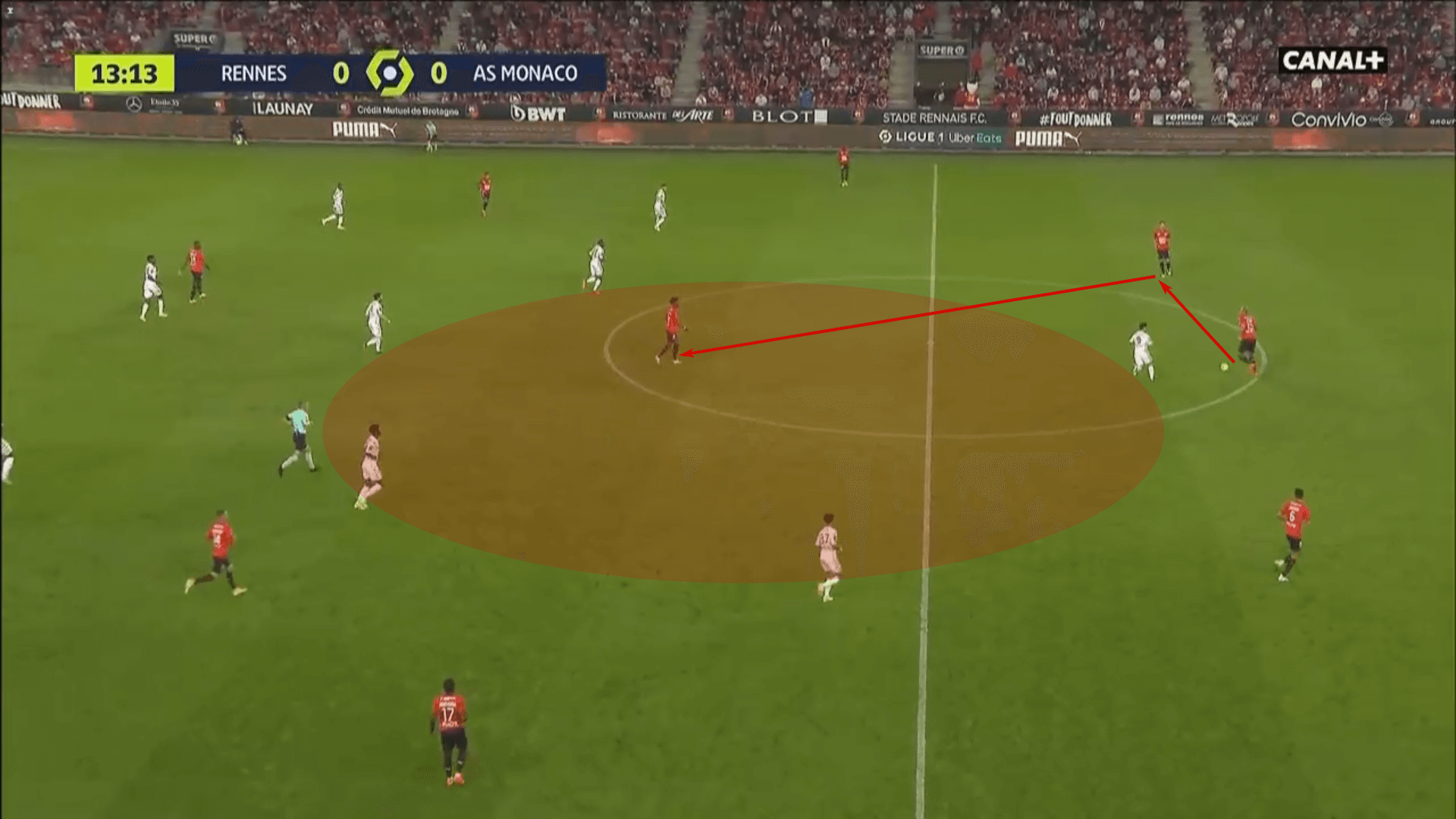
In their Ligue 1 match against Monaco, we saw Nzonzi drop between the two center-backs while Camavinga started higher up the pitch, in line with his two outside backs. His positioning within that red circle is almost perfect. With that starting point, he gives the three deeper players an option to play off of, but he also offers some kind of a central presence which then forces Monaco to become narrower. That in turn frees up space for the long diagonals into the wings.
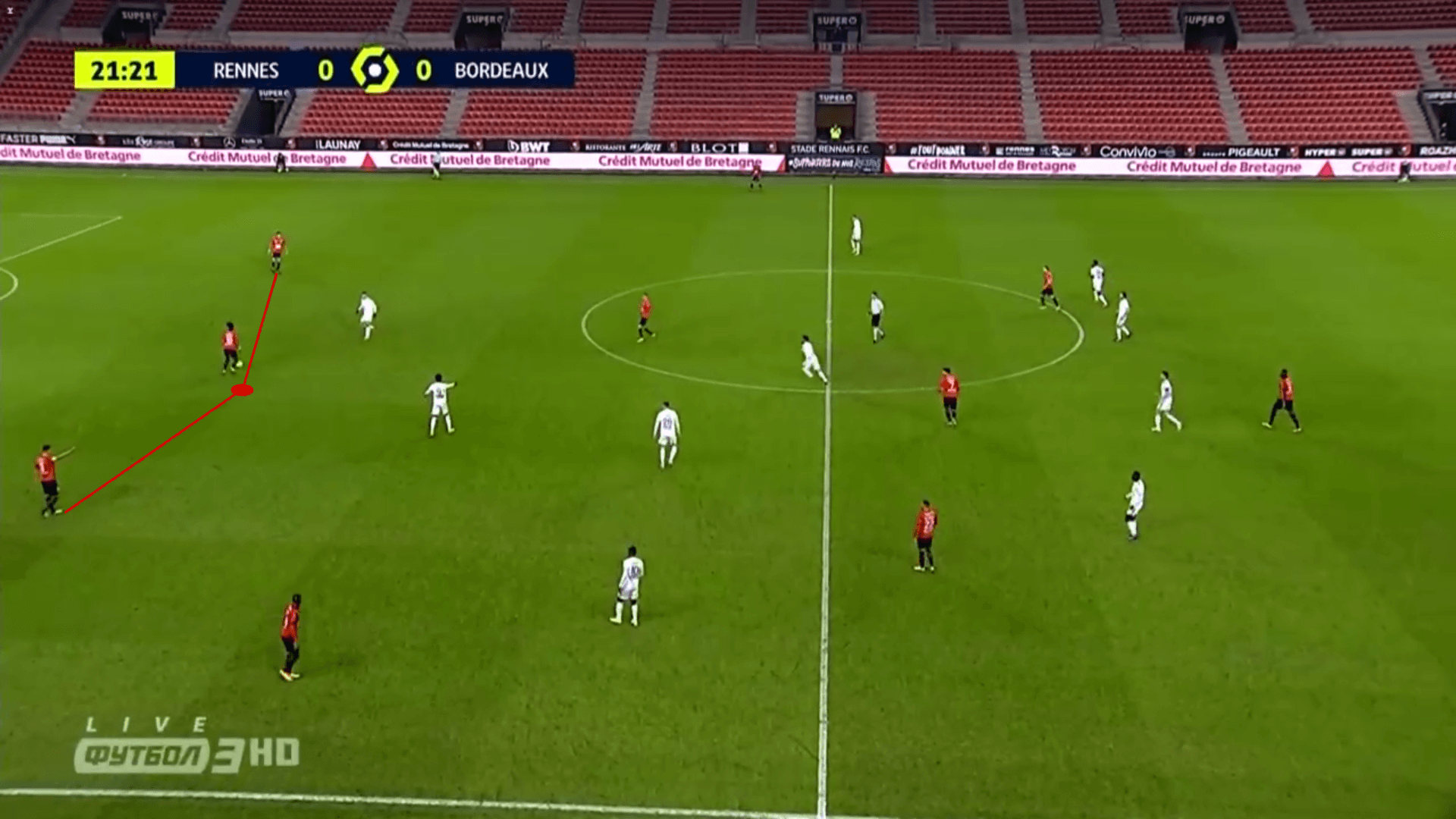
Though it’s typically Nzonzi who drops between the center-backs, Camavinga will occasionally do this as well. In the match against Bordeaux, Camavinga was part of a double pivot with Benjamin Bourigeaud in a 4-2-3-1. Without Nzonzi in the lineup, Camavinga was the one to drop in line with the center-backs. In this matchup, he did venture higher up the pitch, finding gaps in the opposition’s press and dictating play from there, but he was also heavily involved in the build-up from this deep starting point.
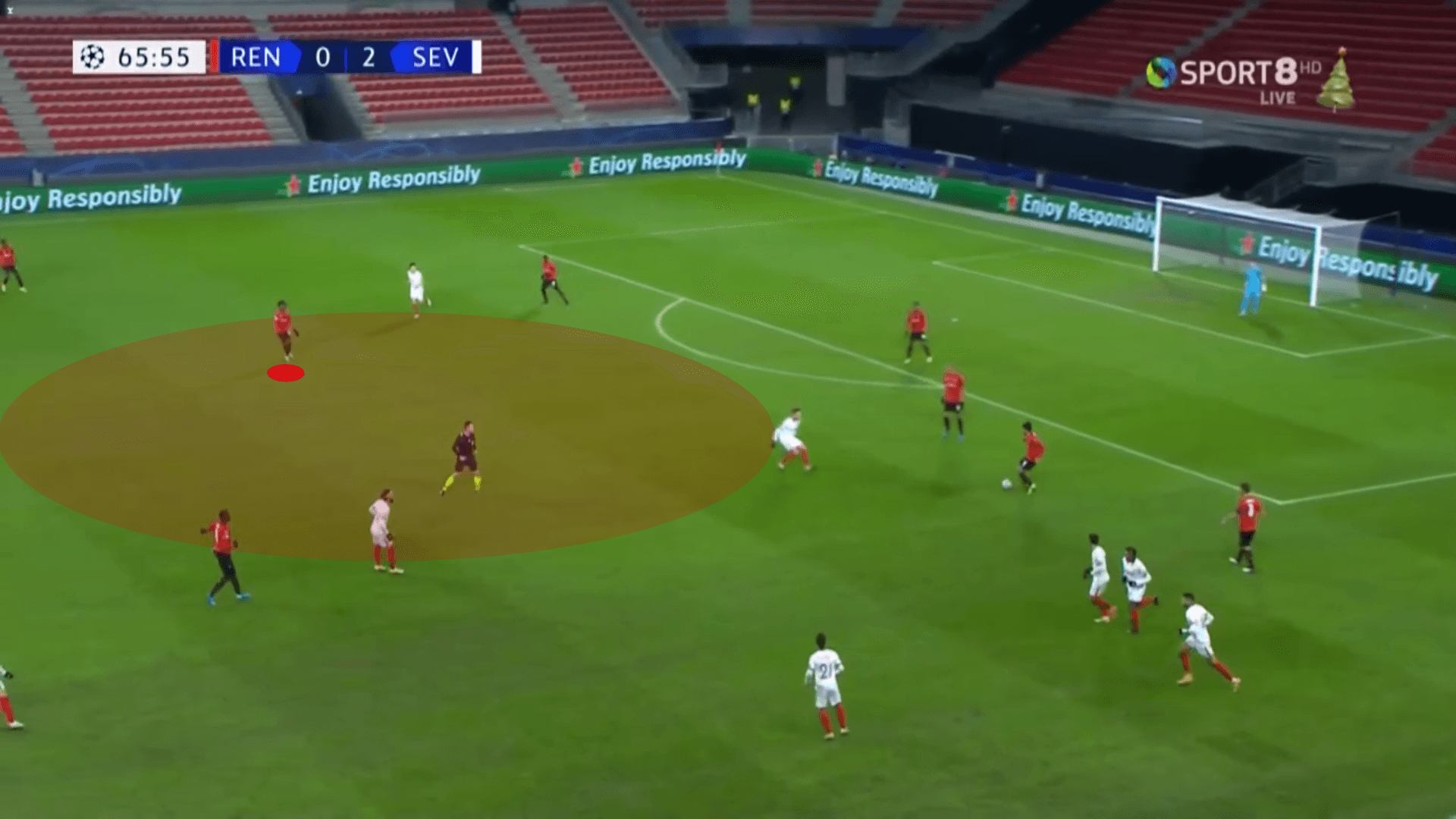
The final point we’ll address regarding the build-up is Camavinga’s ability to help the team play out after a low recovery. Especially with Nzonzi in the game, you’ll see Camavinga use those transitional moments to find and run into gaps in the opposition’s counterpress. If you look closely at the image, his momentum is carrying him into the very middle of the pitch. His arms are out, signaling the available passing lane and to which foot he wants the ball. Finally, his body orientation puts him in a position where he can see his teammate and the ball, as well as the space that he wants to run into.
Even during quick transitional moments or against compact opponent presses, Camavinga’s excellent footballing IQ helps him identify vulnerabilities in the opposition. His ability to read the situation is invaluable to Rennes’ build-out. He’s a press-resistant player with excellent vision and positional awareness. Even if opponents try to single him out in the build-up phases, he’s clever and strong enough on the ball to find his way out of jams.
As the team progresses into the middle third of the pitch, looking to connect their lines as they start to attack the opponent, you’ll either find Camavinga in the half space helping his team maintain possession or more centrally offering an outlet for the switch.
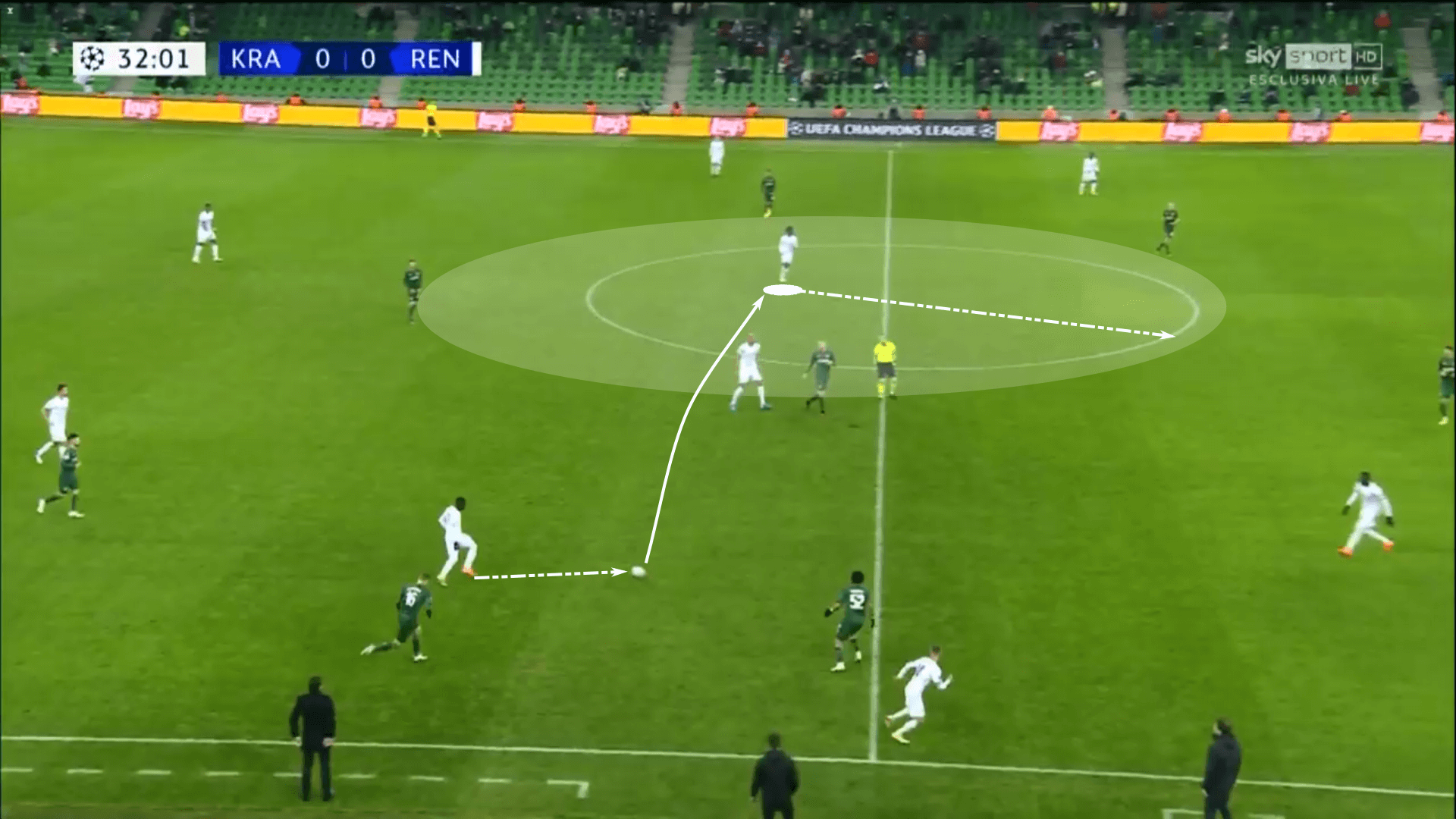
Against Krasnodar, Rennes were progressing the ball through the right side of the pitch. As the Krasnodar defenders became unbalanced on that side, Camavinga remained central, situating himself between four opponents. When the moment to play out of pressure arrived, Camavinga received the pass and progressed the ball through the dribble.
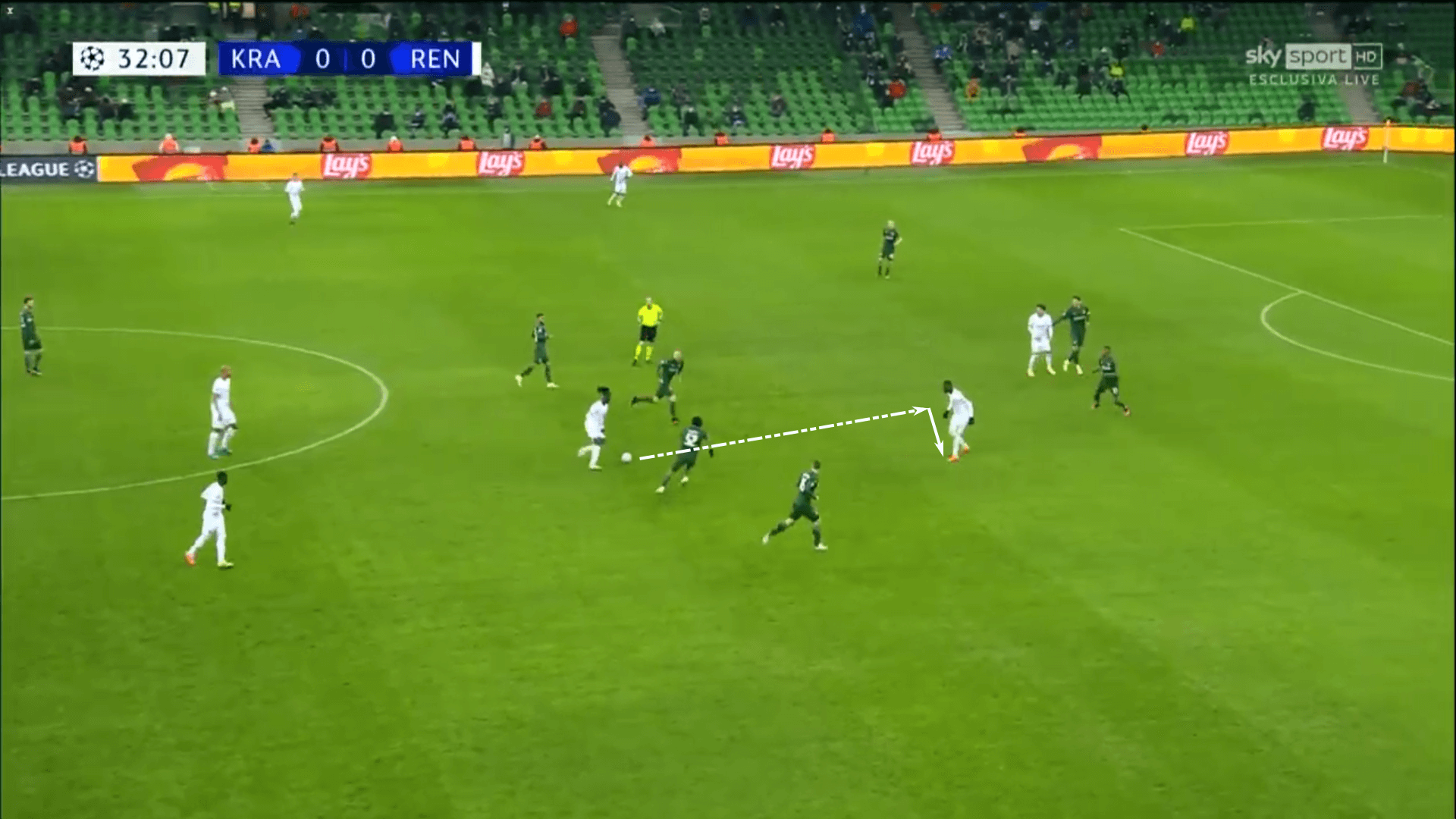
A confident dribbler, even within the tight confines of the midfield, Camavinga split the defenders on the dribble before laying the ball off for James Léa Siliki.
Rating in the top 30 percentile of Ligue 1 center midfielders in dribbles per 90 minutes (2.72), his 50% dribble success rate can certainly improve. That said, there’s certainly some Renato Sanches to his game. Both Ligue 1 players are very direct on the dribble and seem to burst through the opposition’s lines. Camavinga doesn’t have as much power and pace as Sanches, but both players are capable of breaking the game wide open with a single run.
Those runs help Camavinga into the final third of the pitch where Rennes can use his passing ability to play over or through the opposition’s block.
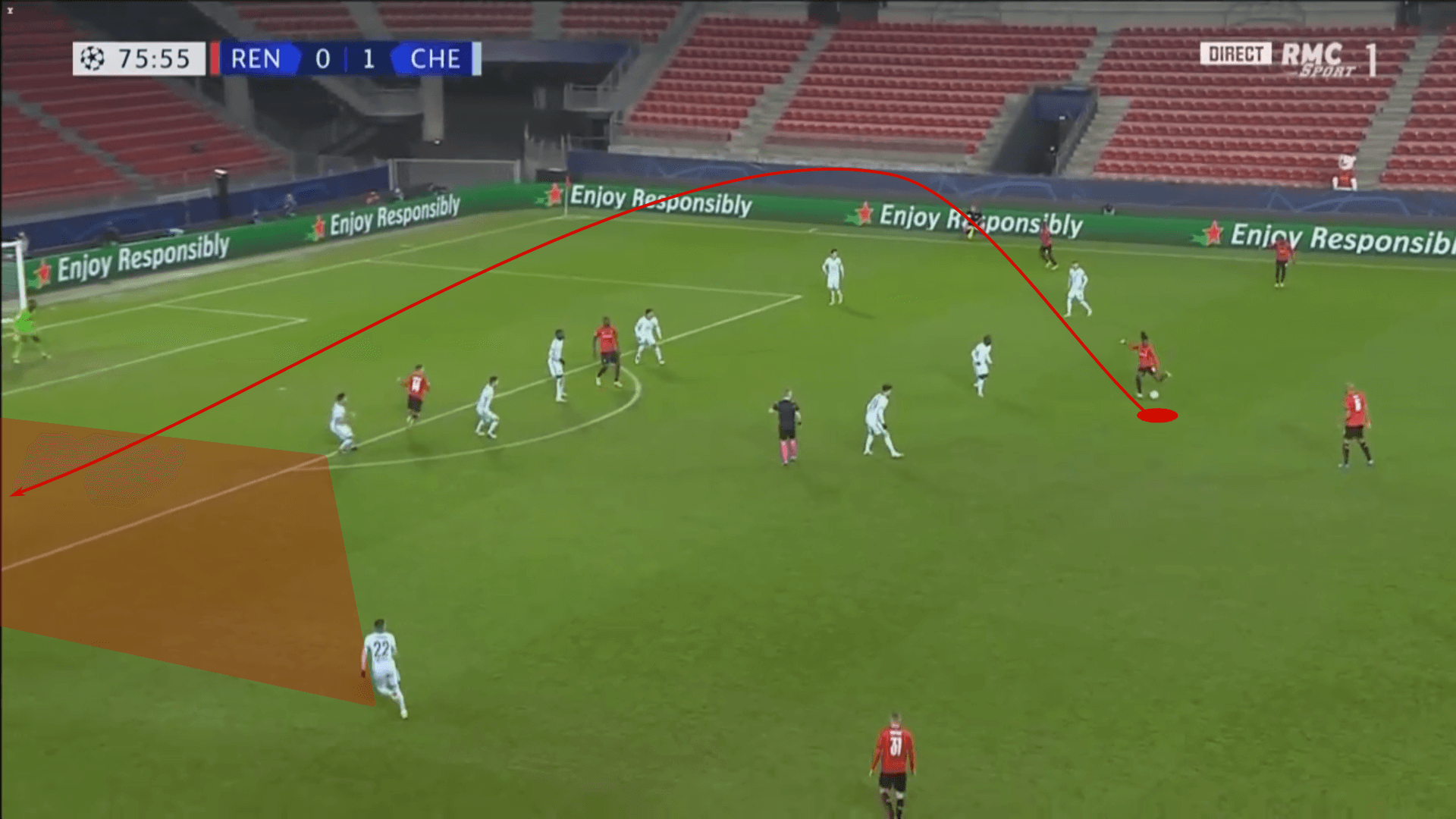
Against Chelsea, the Blues were set up in a 4-4-2 low block with the two lines of four behind the ball. When the ball arrived at Camavinga’s feet, he quickly pushed the ball to his favored left foot and sent a far-post ball over the defense. Though the ball skipped by his teammate, that creative stroke and awareness of the far post runner added an element of versatility as Rennes tried to break through the low block.
If there is one criticism of Camavinga’s passing, it’s that he does tend to play too safe. At times, he’s reluctant to take the space in front of him, opting to simply play negative passes. While the decision doesn’t necessarily harm the team, after all, they usually manage to keep possession, his positioning does allow for greater risk-taking higher up the pitch.
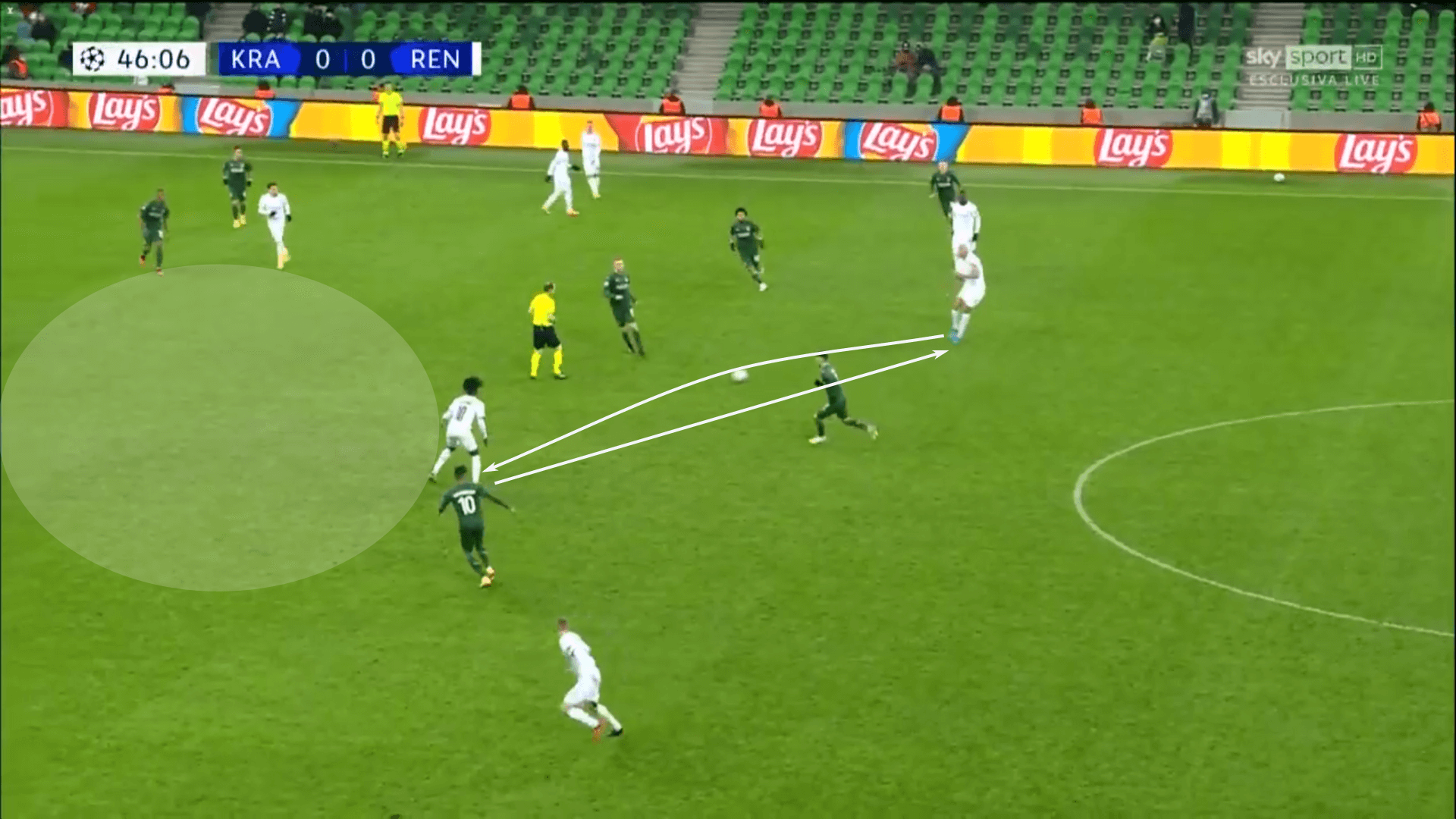
In the game against Krasnodar, there was a moment at the beginning of the second half that really captures this point. Camavinga’s positioning on the play was excellent. As he received the pass, his body orientation would have easily allowed him to run into the space directly in front of him. Instead, he decided to play the ball right back.
His hesitation to take space that’s given to him is interesting. For a player who is typically very confident on the dribble and excels in finding pockets of space to receive, he really could get more out of his dribbling ability by attacking these pockets that emerge. He doesn’t necessarily need to engage in a 1v1 duel, but even dribbling at the next line of defenders and either pulling them out of their shape or pinning them would allow his teammates higher up the pitch to attack the opposition with a variety of high-quality options.
It’s certainly an area of his game that he can improve and one that likely will as he continues to mature and gain confidence.
Is Camavinga an elite defender?
During the 2019/20 campaign, Camavinga made a name for himself with his defensive contributions while playing a deeper role in Rennes’ formation. There was even talk that he could be on his way to Real Madrid to become Casemiro’s heir.
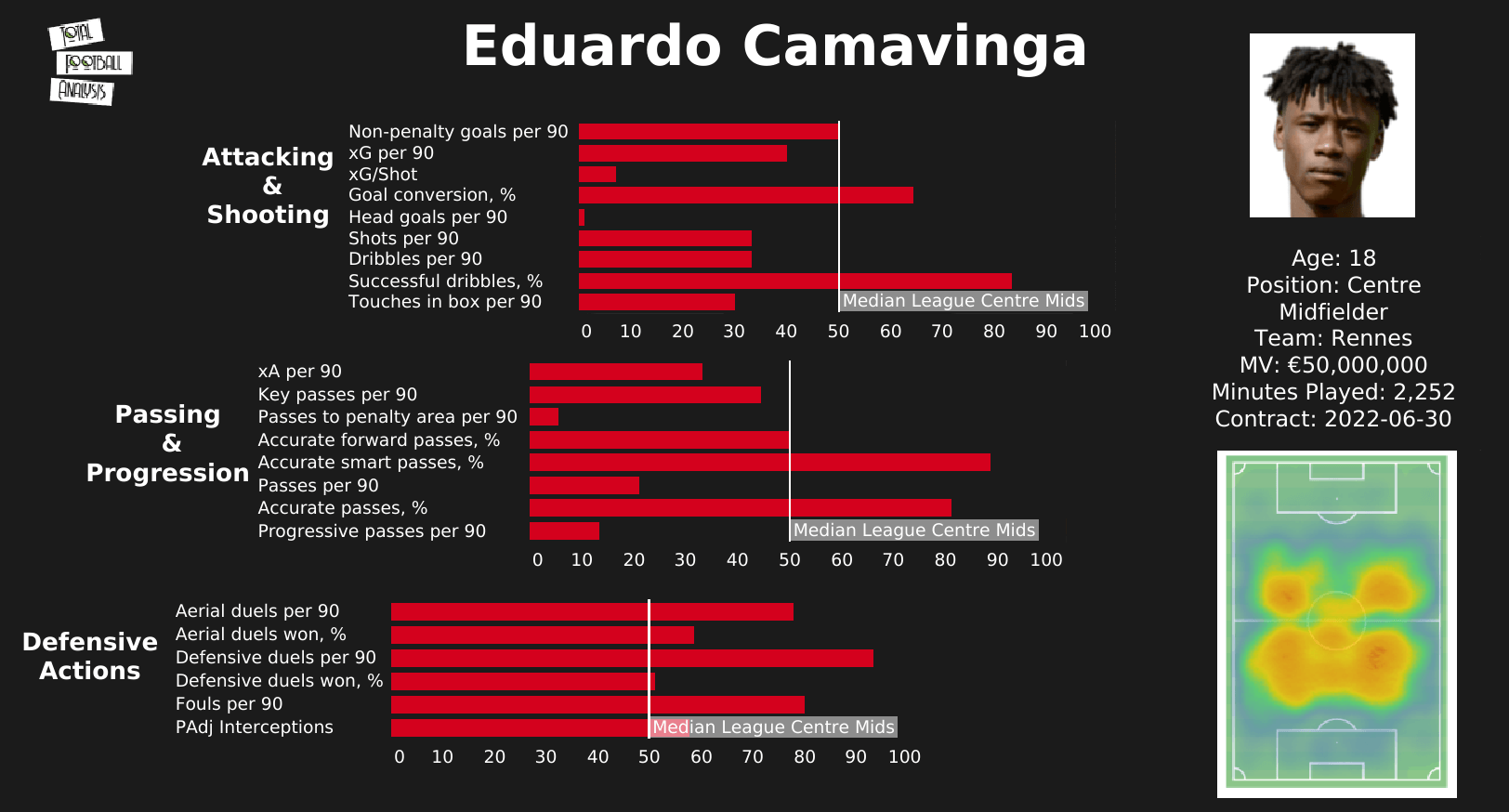
This dashboard shows his 2019/20 stats. Looking at his heat map, the size of those attacking half circles is a little bit smaller than what he’s achieved this far in the 2020/21 season. However, he also covered far more ground in the defensive half of the pitch. Even though he’s a left-footed player, Camavinga was equally comfortable playing on the left or right-hand side of the formation.
Much like the current season, his passing efficiency was one of the strong points of his game. Where we have seen regressions is in the percentage of successful dribbles and his defensive actions. In the current season, only his fouls per 90 and defensive tools per 90 rate above the 50th percentile. Last season, he rated above the league median in each of those six listed categories, even rating among the top central midfielders in the league in aerial and defensive duels per 90 minutes.
So what’s happened?
The higher role certainly impacts his defensive production. Last season, playing deeper allowed him to keep the game in front of him. From that deeper role, it was easier to maintain his sight of the ball and any opponents entering his zone. However, this season, we’ve seen him struggle to cover the gaps behind him.
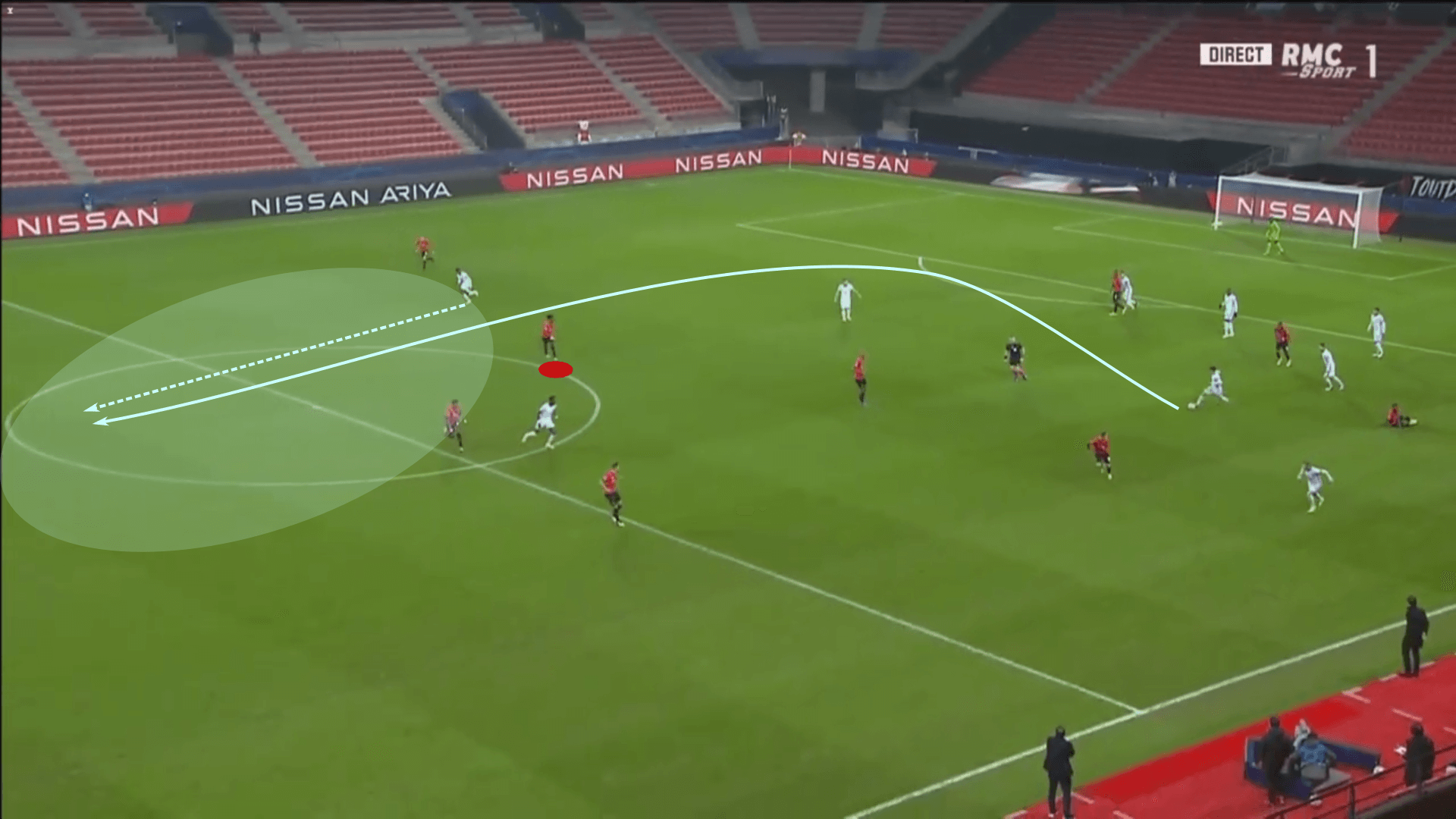
And in the match against Chelsea, Callum Hudson-Odoi was the direct beneficiary of Camavinga’s poor defensive awareness. He doesn’t deserve all the blame. After all, Gerzinho Nyamsi over-commits to his right, leaving a gap in the very middle of the field. However, Camavinga’s positioning put them in a position where he has to help his two center-backs and left-back account for runners. Instead, he remains in no man’s land as Mason Mount delivers a brilliant ball behind the lines. Hudson-Odoi outpaced the defenders to the ball to open up the scoring.
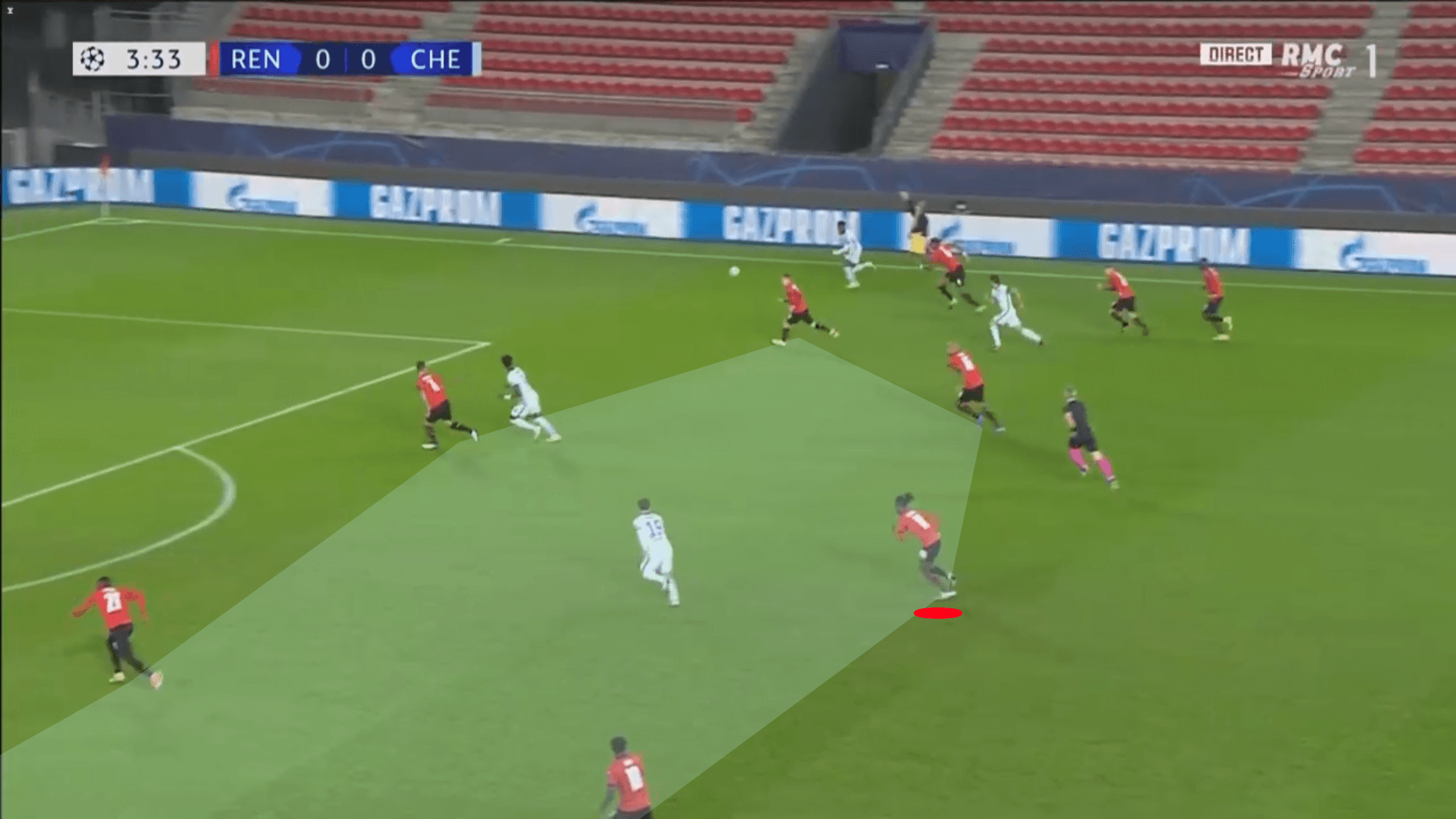
In another sequence from that game, Chelsea managed to break through the right-wing and Camavinga was positioned in the middle of the field near Mount. While watching the ball, the French teenager lost track of Mount, allowing the Englishman to run into the box unopposed.
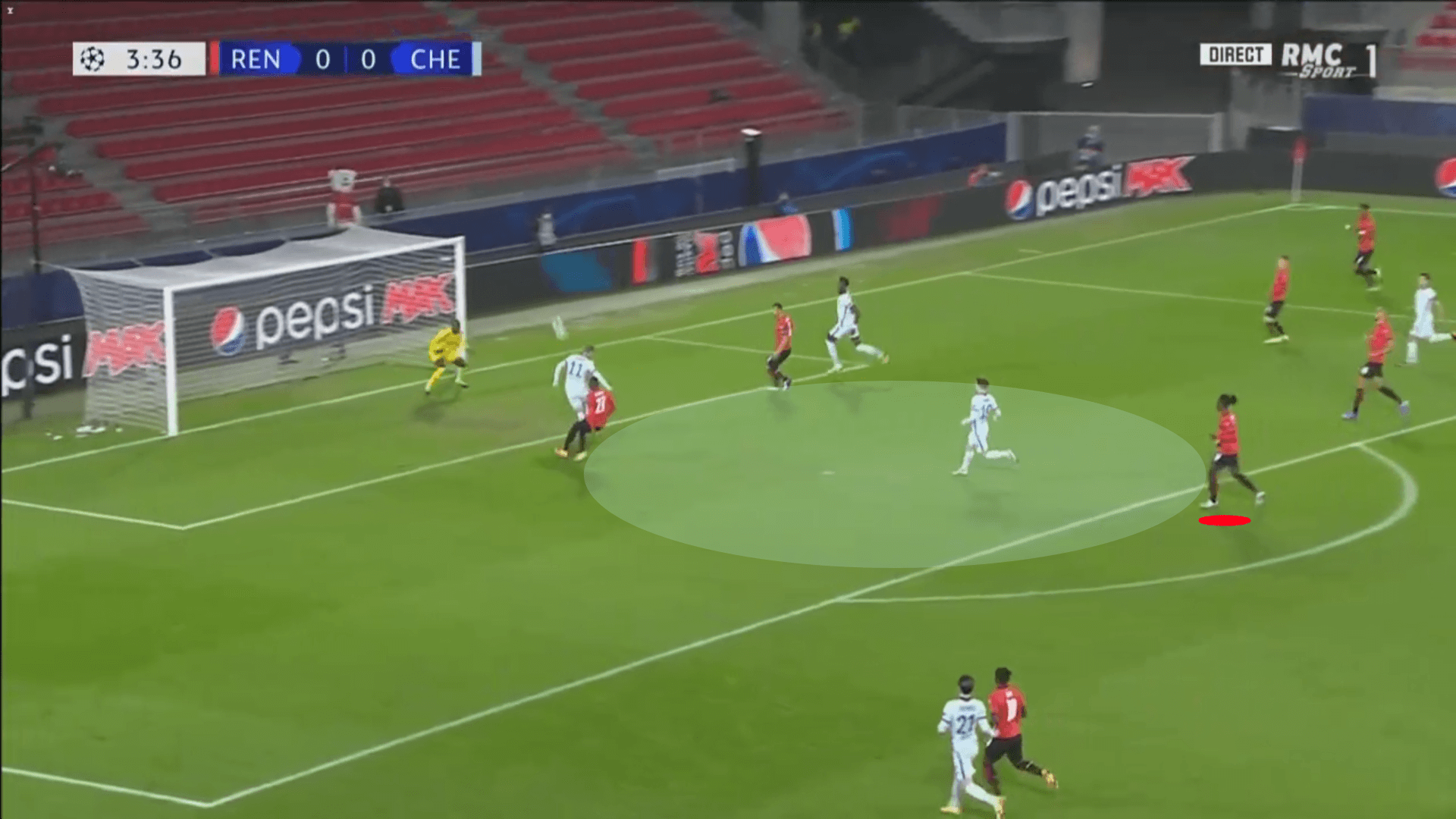
The cross doesn’t reach Mount, but you can see the space he’s found in the box. Camavinga was unaware that Mount had taken up a position behind him and was unable to contest his run into the box.
In each of these situations, the attacker started his run from Camavinga’s blind spot. Poor body orientation and a lack of scanning, which, oddly enough, are major strengths of his when his team is in possession, put him in a situation where he could not recover.
The defensive issues don’t stop there. One of the benefits of having a deeper starting position when out of possession is that a defender can confidently step forward to engage the attack, typically on his own terms. With Camavinga stationed higher up the pitch, many of his defensive involvements require recovery runs, a skill he hasn’t quite mastered.
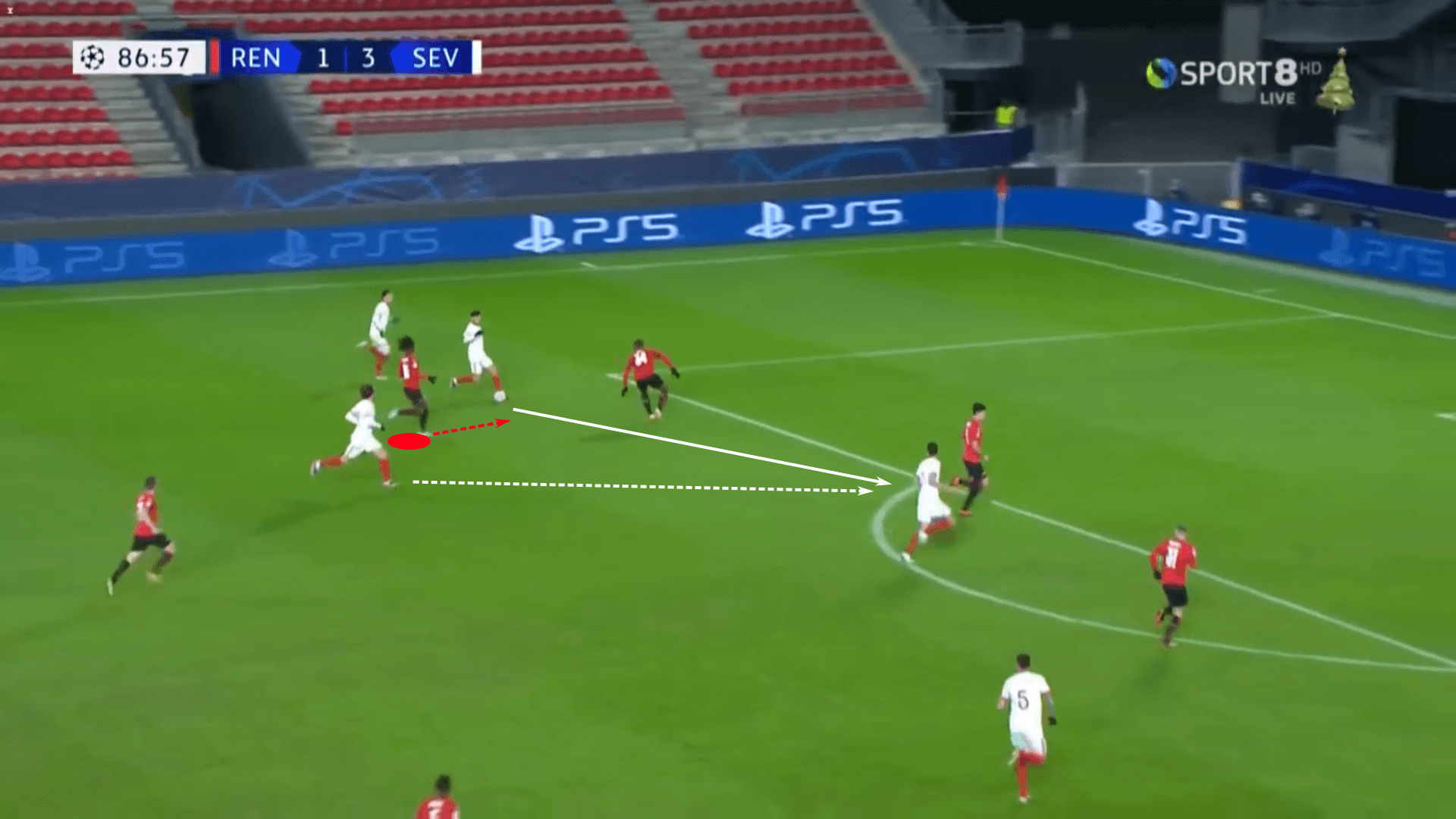
Against Sevilla, the Spaniards had a counterattack that reached the Rennes box and Camavinga was the recovery defender on the play. As Brandon Soppy engaged in a 1v1 duel, a big gap emerged between him and the other center-back, Naif Aguerd. With three Sevilla attackers running through the right half space, Camavinga decided to help pressure the ball carrier. With Soppy in a decent position to engage the first attacker, Camavinga should have run with the inside attacker. In doing so, he would have fulfilled the two-fold mission of taking away the more dangerous player and recovering into a cover position in case Soppy was beaten.
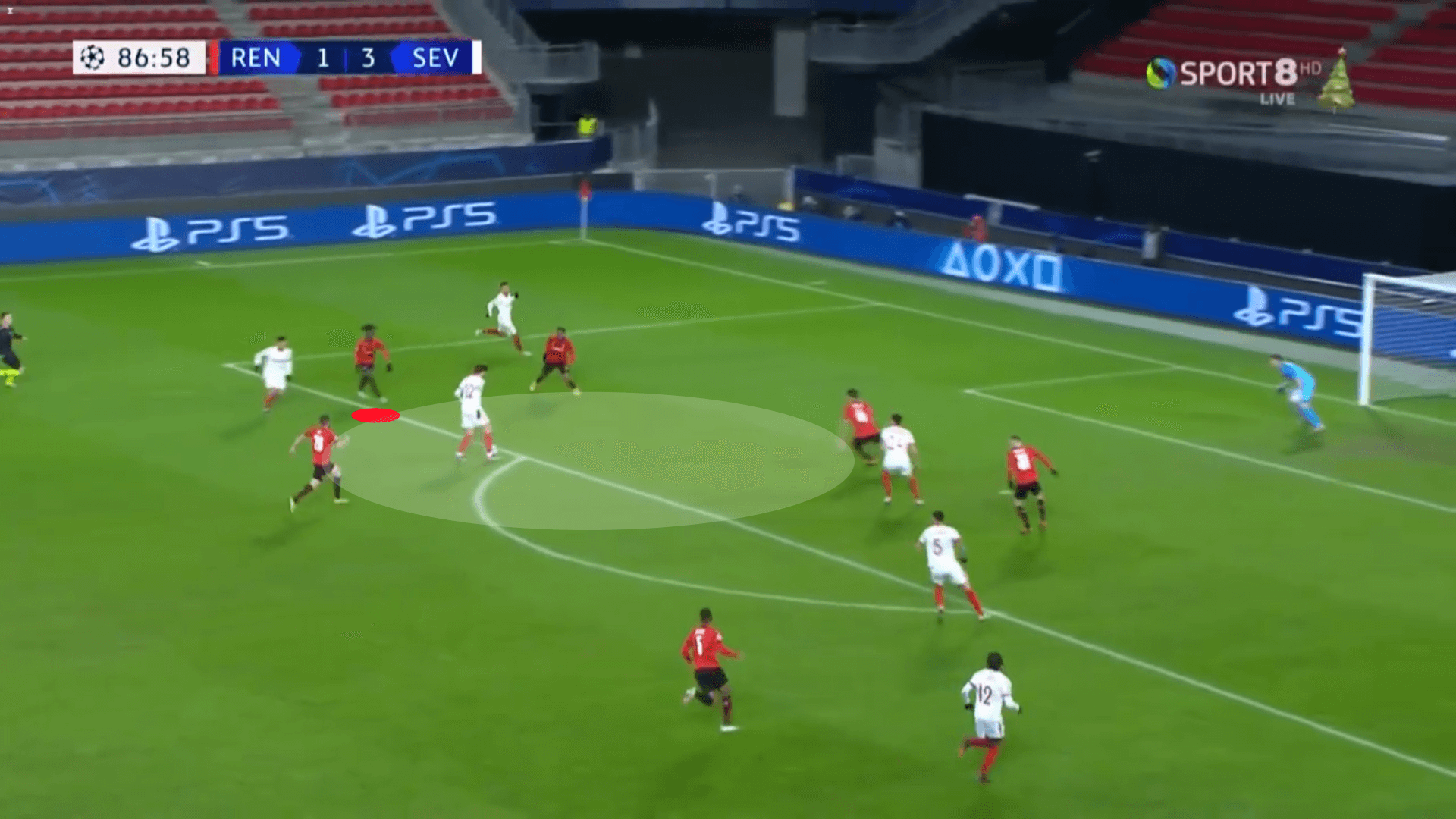
However, as Camavinga and Soppy engage the first attacker, they are easily split, allowing Sevilla to enter the box.
The final defensive point for consideration is Camavinga’s 1v1 defending. Last season, he rated at about the 50th percentile in the defensive duels won percentage statistic. So far this season, that percentile rank has dropped to roughly 20%. Though he is still engaging in a healthy number of defensive duels per game, it is concerning that he is having so little success in his duels.
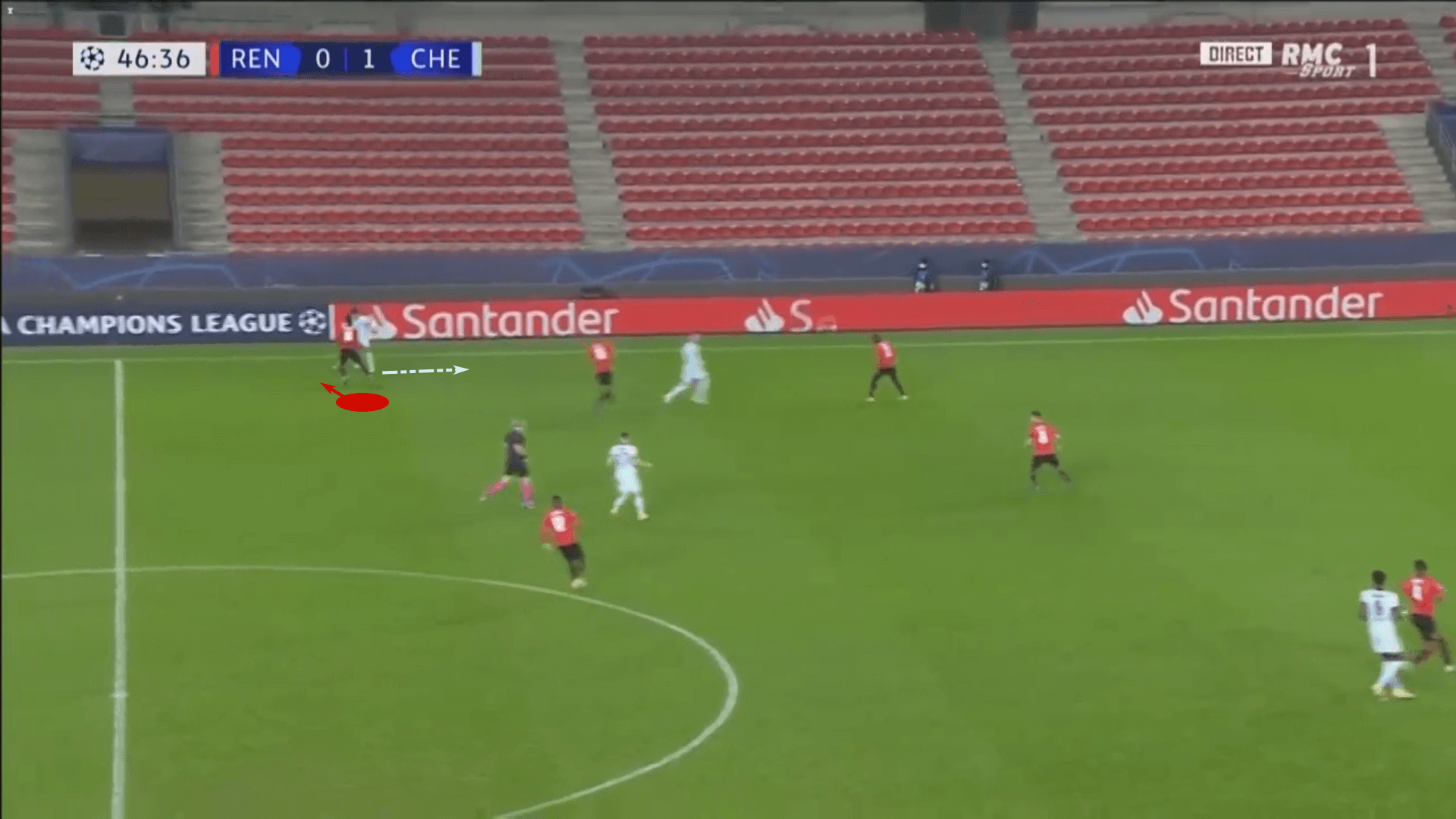
In the match against Chelsea, there is a scenario in the 47th minute that gives us a nice breakdown of some technical issues. With Chelsea moving towards the right side of the image, Camavinga engaged in a 1v1 duel near the touchline. As he looks to go into the tackle, he anticipates his opponent moving negative. If you expand the picture, you’ll see Camavinga’s weight is on his right foot and he’s getting ready for the tackle.
However, his opponent sees that the Frenchman is off-balance, cueing the move to the right. Camavinga went into the tackle from a high, unbalanced position and didn’t read the information he was given. Rather than forcing his opponent to make the first move, Camavinga lunges in and isn’t remotely close on the tackle. Instead, he’s forced to commit the foul, a smart decision in this instance.
The change in role seems to have an influence on Camavinga’s defensive struggles. Still, he may not be the elite defensive player many had assumed.
Conclusion
Rather than a #6, he may be better suited for a box-to-box or attacking mid role where he can use his attacking intelligence and technical ability higher up the pitch.
Throughout his short professional career, we’ve seen him fill a variety of functions in the Rennes midfield. If he plays as a #6, there is the upside of keeping play in front of him. However, the European giant that wins his services will find it more feasible to incorporate Camavinga higher up the pitch.
He can play the #10, but his skill set seems best suited for a box-to-box role. That will allow him to be a major player in the build-out and use his off the ball movement and recognition to help the team connect the lines.
One of the most exciting prospects in the global game, Camavinga is ready to burst onto the scene at a top club. If he is able to secure a transfer in the summer of 2021, fans of the global game can look forward to Camavinga becoming a staple in the UEFA Champions League.

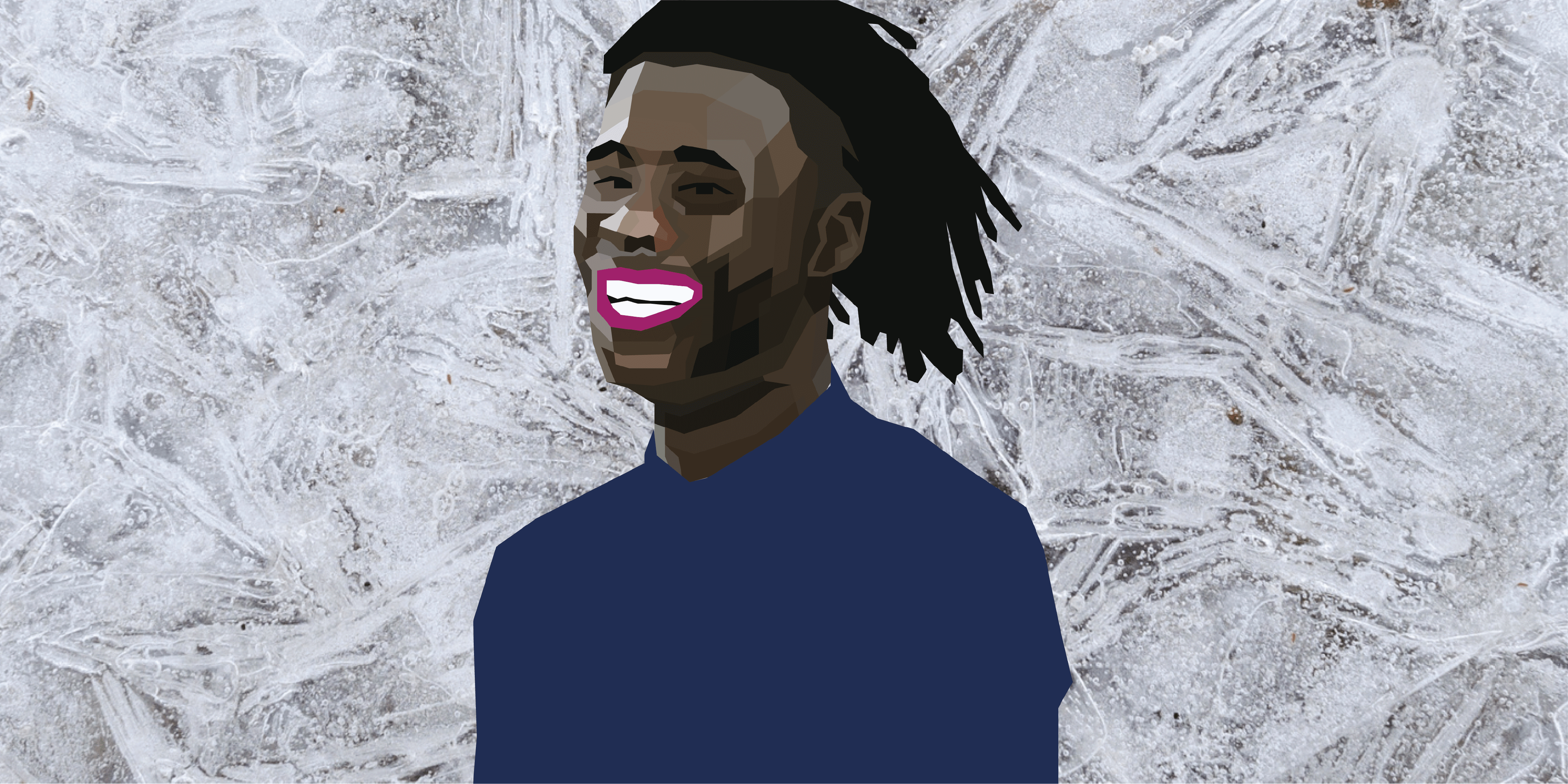



Comments